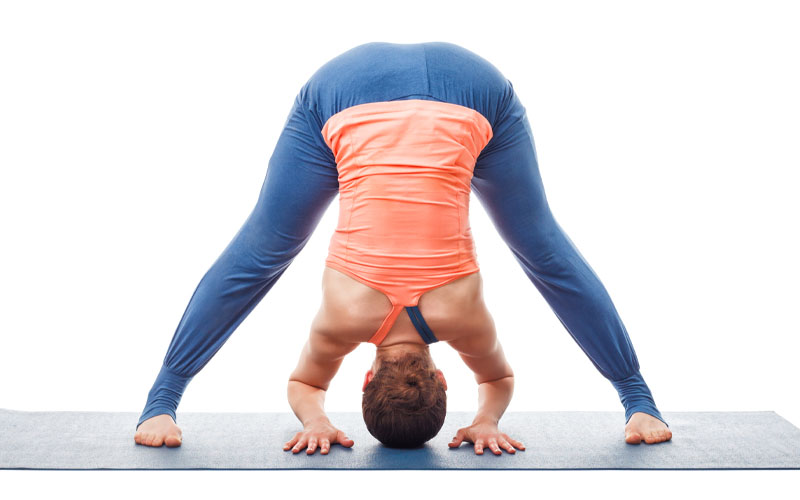Prasarita Padottanasana is one of the most effective types of Yoga pose that you can practice to maintain body posture.
In the modern world, specific Yoga postures are getting another hype nobody can neglect (of course, after the pandemic).
Prasarita Padottanasana is a pose you should start practicing today, to relieve stress and help against worldly problems.
Problems and making yourself believe, “I am enough.”
Hence, in this article, you will find out:
🧘 What is Prasarita Padottanasana Iyengar?
🧘 How can you get into this posture?
And much more.
Be it yoga for beginners or athletes; you will have something for everyone.
So, let’s dive into this “wholesome information.”
Table of Contents
Prasarita Padottanasana Meaning in General
Pronunciation: (Prah-sah-REET-ah- Pah-doh-tahn-AA-SUN-aa)
In English translation, it denotes a Wide-Legged Standing Forward Bend.
Additionally, you can call it a beginner-to-intermediate-level standing hip opener.
All it requires you to stretch the different body parts while relaxing them. Moreover, this yoga pose is specifically designed to treat back, hip and thigh muscles.
“Prasarita Padottanasana is not only the perfect prep for standing poses but for your cool-down, too.”
What Does Prasarita Padottanasana Mean In Sanskrit?
Prasarita is derived from the Sanskrit language, which means “spread apart” or “Extended.” However, Padottanasana, in general terms, comes out as follows:
Pada – Foot
Otta – Intense
Asana – Pose
Thus, Prasarita Padottanasana means “Spread-out-feet intense stretch” in Sanskrit.
Scroll down to know the most flexible ways to get this pose done.
How Do You Perform A Prasarita Padottanasana?
Find below the steps you should follow in order to carry out this yoga form conveniently.
What To Wear?
This exercise won’t restrict you from wearing pajamas, tees, or shorts. Just make sure to go with fitted yet stretchy outfits for a feasible yoga act.
Bring yoga pads home to make any yoga exercise pain-free.
Use slimming patches if you are looking to shed some belly fat too.
Standing Position:
Stand still on the mat, just like you do in the Tadasana position.
Then,
- Stretch or spread your feet to the extended level until stretching more makes you feel uncomfortable.
- Keep your thighs and knee straight, and don’t bend. Better use knee stabilizer pads to make stretching easier.
- Rest your hands on your hips, keeping your back super straight and your inner feet parallel to each other. Use the bunion toe corrector to avoid the risk of your toes falling apart.
- Inhale and lift your chest. While doing so, make your front torso slightly longer than the back and draw your shoulders blades gently towards each other. If you are a beginner, tighten up the shoulders wearing a brace.
- While maintaining the torso length, exhale gradually.

Bending Position
- Next, it’s now time to bend down towards the floor.
- As your torso approaches the floor (folding forward), touch it with your fingers and extend your elbows. In meanwhile, make sure to keep your legs and arms parallel to each other and perpendicular to the floor.
- Then, with a slight movement, bring down your head and let it rest on the floor. Besides, spread your hands pressed on the floor.
- Stay in the position by putting pressure on your head.
- Hold your breath for 30 seconds to 1 minute, and then exhale.

To come out of the Prasarita Padottanasana,
- Take back your hands and put them on the hips with an inhalation. Now, slowly get up (but beware of bending your back or even legs).
- Once you go back in a standing position with stretched legs and lifted chest, you can now walk back to Tadasana’s posture.
- Finally, you can heave a sigh of relief because the pose has successfully been executed. 😉
Don’t Forget To Check Prasarita Padottanasana Precautions
Remember, everything takes time, so you’ll have to be patient.
For instance, when you urge to do exercise daily, you can’t surpass 15 minutes of continuous workout with a happy smile on your face on the very first day. Right?
The same goes with a wide-legged standing forward bend.
Therefore, it is important to note these must-to-follow points:
🧘 Get your body in the most relaxed state to execute this posture. Do not exert force on your body to bend down completely.
🧘 This asana is not good for people who had abdominal or hernia surgery recently.
🧘 Keep your limitations, range, and abilities in mind.
🧘 As this pose puts pressure on your head, so better not to practice it if a migraine is your chronic “pain-partner.”
🧘 People with hunchback should keep their body strength in mind while doing this asana.
What Are The Benefits Of Prasarita Padottanasana
Prasarita Padottanasana’s pose has plenty of benefits. First of all, it boosts the confidence of a person in his own body and reduces depression as it is a great asana when it comes to relieving stress.
Other Prasarita Padottanasana Benefits include:
🧘 It strengthens your hamstrings, feet, spine and encourages introspection.
🧘 It eliminates headaches.
🧘 The pose calms down the brain nerves.
🧘 It tones down the abdominal organs.
🧘 The posture stretches the inner thighs and eradicates pain from the place.
🧘 You will be excited to know that this yoga position helps in digestion.
🧘 It promotes good heart health.
🧘 The inward posture lengthens the spinal bones.
🧘 The pose, when performed, improves flexibility of your different body parts like shoulders, chest, abdomen, hips, back, thighs.
🧘 Do you want to maintain the balance? This will help you to do so.
🧘 It makes your walk strong. How? Well, it supports the calf muscles and ankle muscles.
🧘 Prasarita Padottanasana alleviates stiffness of the back muscles.
Additionally, to astonish your walker friend, you can get some useful gifts.
Prasarita Padottanasana (a,b,c,d) Variations

Other than pressing your hands on the floor (the way we discussed earlier – consider it variation A or Intense Leg Stretch Pose), you can bring about this posture in many ways, like:
Variation B: Clasp your hands together by extending your arms while your head is touching the ground. One of the best Prasarita Padottanasana b benefits is it treats hand fatigue.
Prasarita Padottanasana C: Just keep your hands on the hips when you bent forward until you get back straight.
Prasarita Padottanasana D: Clasp your toes and two fingers by grabbing the outer edge of the feet. Keep in mind to bend your elbows over the wrists
Prasarita Padottanasana Twist: This wide-legged standing forward bend is another diversity we can perform to stretch the body parts. It allows a person to touch the land with one hand while the other one is hanging in the air (in an upward direction). The asana improves full-body coordination

Other good variations are:
🧘 Seated Wide-Legged Forward Bend Pose Hands Chair
🧘 Pendulum Pose
🧘 Five-Pointed Star Pose Arms Up
Hence, any variation you try, all of these asanas predominantly treat and work on the lower back and its posture.

Prasarita Padottanasana – Tips For Ease
This is not just a posture but an activity you can carry out to prepare your body for meditation and inversions.
🧘 Enforce a little bit of exertion on your legs and thighs.
🧘 Let calmness rule you, and never show distress on your face. It means to keep your gaze and face soft.
🧘 For comfort in the initial days of practice, place a block underneath your head to feel the floor. Try Wide-Legged Forward Bend Pose while placing your head on such blocks.
🧘 If you face a failure in keeping your back straight (means if it goes round), come back to your real position and accept your body’s boundaries.
🧘 Make sure your hamstrings are tight, so the forward bending doesn’t affect your body parts’ posture.
FAQs
Who Should Not Do Prasarita Padottanasana?
Some of the contraindications are: People with high blood pressure, severe knee pain, or back problems should avoid performing this yoga step. Those who have hamstring tears are also included in the list.
Also, students (irrespective of their age) and fibromyalgia or arthritis patients should consult their doctor before they start getting into the pose.
What Is Urdhva Prasarita Padottanasana?
It is commonly known as the “Upward extended feet pose,” which targets the hip flexor muscles and deep abdominal.
It is quite different from Prasarita Padottanasana. As in this pose, your hips touch the floor.
Does Yoga Help With Hunchback?
Yes, it does. It improves and regains spinal strength by providing flexibility and maintaining good body posture.
Bottom Line
As Shilpa Shetty Kundra (Indian Actress and Yoga Enthusiast) shares her point of view regarding Yoga in her Instagram post’s caption:
“It is very important to begin something with a clear mind and a positive attitude. It could be a new venture, a new task, or a new day. The best way for me to start my day and week is with Yoga.”
So, if you really want to enjoy a FRESH start of the day, practice different yoga exercises daily.
Stay fit! Stay healthy!


